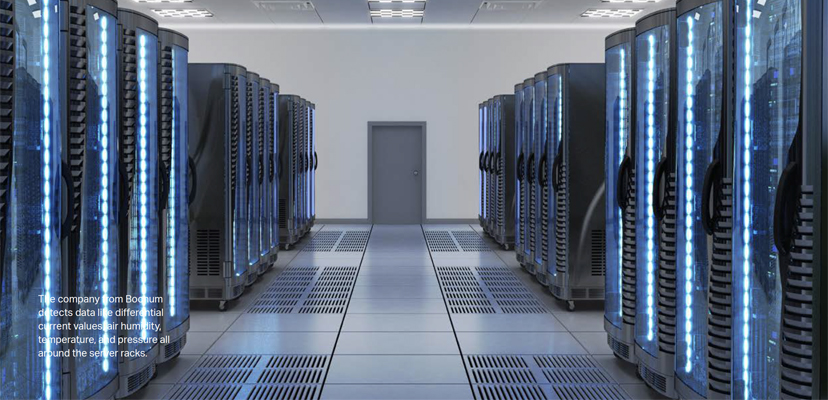


If hackers or a technical glitch paralyze the servers of a corporation, the failures can lead to millions in damage. One company, Correct Power Institute, has developed a method for monitoring computer centers that quickly traces faults in the power supply to maximize uptime for the IT systems. The approach: Controllers from WAGO detect all electrical current and environmental data and use the cloud for analysis. The hardened Linux® operating system in the WAGO controllers and Correct Power’s sophisticated security architecture ensure the highest level of data security.
Imagine an automotive manufacturer in Stuttgart: In the middle of the morning shift, production suddenly stops. Belts stop, the swift movements of the parts robots freeze, the touch screens for the production engineers go dark. Later, it becomes evident that cyber criminals attacked the manufacturer’s computing center and cut the power supply to the servers. In places where Industry 4.0 has been implemented, where the most important processes are controlled via IT, this is an expensive experience: It is estimated that the company would have to absorb 20 million Euros in losses due to this production stoppage.
This example may be invented, but it is also quite real, as almost all of the largesized companies, banks and insurance groups are outsourcing their IT to computing centers. These constantly process, analyze and store data, and often in the cloud, which provides enormous additional IT capacities. Yet therein lies the rub: Server farms can be easily attacked via the Internet if their IT security is not robust. Hackers increasingly exploit these weak points to infiltrate viruses into code, steal data, or cripple the power supply.
“Power supplies are the Achilles’ heel of servers,” explains Bernd Steinkühler, CEO at the Correct Power Institute GmbH. The company from Bochum, Germany specializes in constructing and monitoring server farms. The problem: Even though electrical supplies are regulated by standards and requirements, these are often not fully implemented. “There are many rules and regulations, and it is easy for operators to lose track. Monitoring is often lacking, and problems are not detected early enough,” states Steinkühler. This can have fatal results for a company. If IT does not work around the clock, then production and competitiveness are negatively impacted.
Analysis in the Cloud using Azure
Correct Power can provide remedies: The company has developed a monitoring concept for server farms that targets maximum power availability. “To meet the demands for availability and security in modern computing centers, we have to examine the electricity more explicitly in order to detect and evaluate the residual currents in greater detail. We test the current extensively,” explains Marcel Steinkühler; he is in charge of Sales and Marketing at Correct Power.
Controllers from WAGO play an essential role. They collect current and environmental data from up to 15,000 data points per server farm and send them for analysis and archiving to Microsoft’s Azure platform, which is in turn managed by the Telekom subsidiary, T-system. “This provides us with concentrated big data intelligence. In addition, Azure offers a high level of data monitoring, because T-system functions as a German trustee to control access,” according to CEO Bernd Steinkühler. Differential current values, which are detected in the server racks at the computing center, form the basis for Correct Power’s analysis. Differential current is, per definition, the vectorial sum of the currents of all active conductors at a specific point in an electrical system. Because the currents flowing in and out of the racks have to be balanced, this should be equal to zero. “When deviations arise, there is probably a fault, and our system sounds the alarm,” explains Steinkühler. The company also monitors environmental values, like humidity, temperature, and pressure. If it becomes too hot in the server rooms, the sensitive servers operate at reduced output and increased power consumption.
In such cases, the temperature is automatically regulated by the climate control systems and the cloud sends a warning message.
It all sounds easy; however, it is based on a sophisticated system. The specialists at Correct Power considered data security extensively in their design. “Many marketable controllers simply do not offer what we need in this regard,” states Steinkühler. These controllers are based on Windows and thus require regular security updates. “This is linked to an enormous expense and does not fit our high security requirements.” Therefore, Correct Power selected the PFC200 Linux® controller from WAGO. “Security by Design” – IT security integrated from the outset in the form of layer-based security architecture – ensures that data thieves will have serious problems with these controllers. “We are enamored by the hardened Linux® operating system,” opines Steinkühler. Core of the Security Chain
The Bochum company’s designers cannot conceive of their concept without the PFC200. It automatically transfers selected values at defined intervals to the firewall of Palo Alto Network, a security firm. Communication is secured by an encrypted VPN connection using the proven MQTT protocol. Palo Alto evaluates the information, detects intruders, and repels attacks from the IT. They subsequently pass the “clean” values via the Internet to Azure for further cloud processing “Due to this intermediate step, our monitoring solution has become the Fort Knox for data,” says Steinkühler.
The “Asset Management Cloud,” developed by the WAGO subsidiary M&M, receives the data through Azure (also see page 30). A Web portal serves as the user interface, what allows adjustments to be made, for example, regarding what information is eventually stored in the cloud or which measured values will trigger alarms.
The information can be clearly displayed in the forms of tables and diagrams on a dashboard and in the data warehousing database supported by Correct Power. “The good thing about the solution is that we have access to current and historical data, regardless of location,” explains Steinkühler.
Industrial firms, banks and insurance companies have displayed interest in Correct Power’s monitoring systems. They have already been implemented by IT specialists in twenty server farms across Europe, Asia and Australia, and are to be provided in ten others. As their next project, Correct Power is planning to use Azure for failure prediction and to develop new operating strategies for increasing the availability of the servers. “Problems often result from unfavorable correlations. We want to use artificial intelligence, known as machine learning, to detect and prevent errors,” explains Steinkühler.
Experts see important topics for the future in machine learning and neural networks, because with their help, it will be possible to use energy consumption and process data for predictive maintenance. Production systems will no longer be repaired when they fail, but before they do. This will prevent long idle times and the associated costs. WAGO can also facilitate a step in the direction of Industry 4.0, because their controllers can be used as central data managers for analog and digital information with secure links to the cloud.
TEXT MARTIN WEIßMÜLLER AND SASCHA RENTZING ׀ WAGO FOTO CORRECT POWER INSTITUTE, WAGO, Fotolia